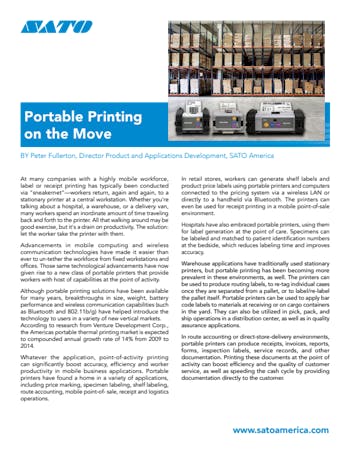At many companies with a highly mobile workforce, label or receipt printing has typically been conducted via "sneakernet"—workers return, again and again, to a stationary printer at a central workstation. Whether you're talking about a hospital, a warehouse, or a delivery van, many workers spend an inordinate amount of time traveling back and forth to the printer. All that walking around may be good exercise, but it's a drain on productivity. The solution: let the worker take the printer with them.
Advancements in mobile computing and wireless communication technologies have made it easier than ever to un-tether the workforce from fixed workstations and offices. Those same technological advancements have now given rise to a new class of portable printers that provide workers with host of capabilities at the point of activity.
Although portable printing solutions have been available for many years, breakthroughs in size, weight, battery performance and wireless communication capabilities (such as Bluetooth and 802.11b/g) have helped introduce the technology to users in a variety of new vertical markets. According to research from Venture Development Corp., the Americas portable thermal printing market is expected to compounded annual growth rate of 14% from 2009 to 2014.
Whatever the application, point-of-activity printing can significantly boost accuracy, efficiency and worker productivity in mobile business applications. Portable printers have found a home in a variety of applications, including price marking, specimen labeling, shelf labeling, route accounting, mobile point-of- sale, receipt and logistics operations.
In retail stores, workers can generate shelf labels and product price labels using portable printers and computers connected to the pricing system via a wireless LAN or directly to a handheld via Bluetooth. The printers can even be used for receipt printing in a mobile point-of-sale environment.
Hospitals have also embraced portable printers, using them for label generation at the point of care. Specimens can be labeled and matched to patient identification numbers at the bedside, which reduces labeling time and improves accuracy.
Warehouse applications have traditionally used stationary printers, but portable printing has been becoming more prevalent in these environments, as well. The printers can be used to produce routing labels, to re-tag individual cases once they are separated from a pallet, or to label/re-label the pallet itself. Portable printers can be used to apply bar code labels to materials at receiving or on cargo containers in the yard. They can also be utilized in pick, pack, and ship operations in a distribution center, as well as in quality assurance applications.
In route accounting or direct-store-delivery environments, portable printers can produce receipts, invoices, reports, forms, inspection labels, service records, and other documentation. Printing these documents at the point of activity can boost efficiency and the quality of customer service, as well as speeding the cash cycle by providing documentation directly to the customer.
While portable printers are a boon to efficiency and accuracy, selecting the right printer for the application is a must. There are a number of factors that affect printer selection: How long does the battery last? What's the maximum roll capacity? What about print speed? The goal is to keep your mobile workforce up and running as long as possible with the least amount of downtime, so you want a device that can print enough labels for your application, and do so in the most efficient manner. The fewer times your employees have to re-load labels or recharge the battery, the more productive they are.
Size and weight are also important. Heavier printers can be used for in-vehicle systems, where they may be mounted to a forklift or other mobile warehouse equipment. But beltworn printers must be ergonomically designed and light enough that they won't pull your uniform down. By the same token, the printer must be durable enough to withstand the inevitable wear and tear of an industrial application. The SATO MBi Series portable printers, for example, are light weight, yet can withstand multiple drops to concrete in accordance with MIL Standards testing 810F.
In the past, portable printers typically communicated with mobile computers via cables or infrared links based on the IrDA specification. Neither of these options is perfect. Cables can break and be costly to upkeep and infrared connections (which require line of sight) aren't reliable in certain environments.
Fortunately, there are a number of wireless options available for portable printers. Adding wireless communication to a portable printing system can initially seem more expensive than using standard cables, but once the cost of replacing broken cables over the life of the application is figured in, wireless is often the more cost-effective option. Many portable printers, like the MBi Series, are available with standard cable connections, as well as multiple optional wireless interfaces.
For short-range communication to a mobile computer, Bluetooth has emerged as a robust alternative. Bluetooth runs on the same radio frequency as most wireless LANs (2.4 GHz), but it has a shorter range. Because it doesn't require line-of-sight to operate and is a faster mode of communications, it's a huge improvement over infrared, and a safer option than dangling cables.
Printers can also be connected to enterprise systems via IEEE 802.11b/g-based wireless LANs, meaning that portables can be addressable, just like any other printer on the network.
With the right portable printer and communications technology, it's possible to increase the productivity of the on-the-go workforce, boost efficiency, improve customer service—and eliminate the hidden cost of "sneakernet."
At many companies with a highly mobile workforce, label or receipt printing has typically been conducted via "sneakernet" - workers return, again and again, to a stationary printer at a central workstation. Whether you're talking about a hospital, a warehouse, or a delivery van, many workers spend an inordinate amount of time traveling back and forth to the printer. All that walking around may be good exercise, but it's a drain on productivity. The solution: let the worker take the printer with them.
